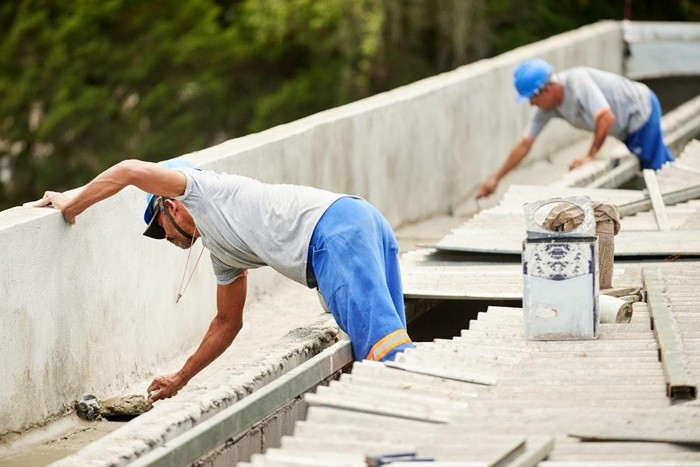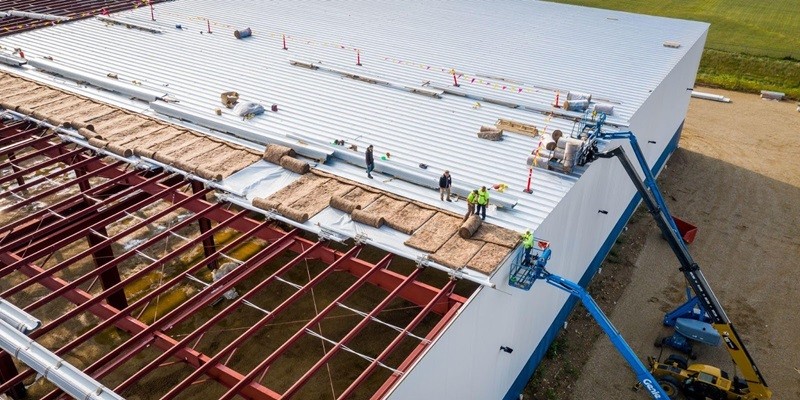A commercial roof does a lot of heavy lifting. It’s up there in all weather—taking in the heat, deflecting the rain, holding steady through storms, and protecting your business. But a roof is only as dependable as the care it receives. Regular maintenance keeps it strong and responsive, preventing small issues from becoming costly. Small, proactive steps can make the difference between years of reliable protection and costly repairs that can disrupt your business.
Why Is Regular Roof Maintenance Important?
Routine roof maintenance is essential for avoiding issues that could disrupt daily operations. Especially in commercial roofing installation, maintenance goes beyond repairing leaks or worn areas; it safeguards the building’s safety, boosts energy efficiency, and preserves long-term value. Neglecting regular upkeep can allow minor problems to escalate into costly repairs.
The Key Benefits of Regular Roof Maintenance
When you prioritize regular roof maintenance, your commercial building benefits in multiple ways:
1. Longer Roof Life
Routine inspections and repairs help prevent issues that shorten a roof’s lifespan, giving you more years of use and reducing the need for early replacement.
2. Cost Savings
Spending a little on maintenance saves significantly in repair costs. By tackling minor problems, you avoid larger expenses down the road.
3. Improved Safety
Regular upkeep keeps the roof structurally sound, protecting everyone in the building and reducing liability risks.
4. Energy Efficiency
An intact roof is a more energy-efficient one. A well-maintained roof minimizes heat loss in winter and keeps the building cool in summer, helping lower energy bills.
5. Increased Property Value
A building with a well-maintained roof holds its value better, offering better resale options and appealing to potential tenants or buyers.
Recognizing Signs Your Roof Needs Attention
If you’re noticing water stains, damaged flashing, or visible debris on your roof, it’s time to schedule maintenance. Here are a few common signs that indicate your roof needs attention:
Leaks and Water Stains
Water intrusion or dark stains on ceilings are telltale signs of roof trouble. Addressing leaks promptly prevents costly water damage and mould issues.
To better understand how roof leaks can impact commercial roofs, this video provides a detailed breakdown of common causes and solutions for leaks in commercial roofing systems. Watch the video here.
Ponding Water
Water not draining within 48 hours can erode roofing materials and cause structural problems.
Damaged Flashing or Membrane
Missing or damaged flashing around roof edges, vents, and skylights makes your roof vulnerable to water damage.
Cracks, Blisters, and Bubbles
Bubbles or blisters in the roof membrane suggest trapped moisture, weakening the roof’s structure and requiring prompt repair.
What Does a Comprehensive Roof Maintenance Plan Include?
Routine maintenance involves several key tasks to keep your roof strong and reliable. Here’s what a comprehensive plan covers:
1. Biannual Inspections
- Schedule professional inspections at least twice yearly, in spring and fall, to identify and resolve issues early. If your building experiences harsh weather, you may need additional checks.
2. Clearing Debris and Drainage
- Leaves, branches, and other debris clog gutters and downspouts, causing water to pool. Regularly clearing this debris protects your roof from water damage and prevents buildup that can weaken roofing materials.
3. Addressing Minor Repairs Promptly
- Small tears, worn flashing, or cracks may not seem urgent but can quickly worsen. Prompt attention to these issues keeps the roof in top condition.
4. Sealing Roof Penetrations
- Areas around vents, HVAC units, and other penetrations are prone to leaks. Resealing these spots as needed keeps moisture out and reduces wear.
5. Testing Drainage Systems
- Regularly inspect and test drains and gutters to make sure they’re channelling water away efficiently. This step is especially crucial for flat roofs.

How Often Should Commercial Roofs Be Maintained?
Maintenance frequency depends on factors like location, roof type, and age:
Location
Consider more frequent inspections in regions with heavy rainfall, snow, or extreme temperatures.
Roof Age
Older roofs need more care to remain secure and functional. As roofing materials age, they’re more susceptible to damage.
Roofing Material
Different materials have unique needs. Consult a roofing professional familiar with your roof type to develop an ideal maintenance plan.
Preventative vs. Reactive Maintenance
Preventative maintenance allows you to avoid the high costs of emergency repairs. By scheduling regular inspections and repairs, you’re not just reacting to problems—you’re stopping them before they start. Reactive maintenance can be far more expensive, often due to more extensive repairs and possible business disruption.
Steps to Implement a Maintenance Plan
Getting a maintenance plan in place is easy when you know the steps:
1. Partner with a Trusted Roofing Contractor
Look for experienced roofing professionals with a record of working on commercial roofs. Regularly working with a trusted team ensures quality work and a roof that holds up against the elements.
2. Create a Maintenance Schedule
Develop a consistent schedule for biannual inspections and after significant weather events. Consistent care protects your roof from unseen issues that could escalate.
3. Keep a Maintenance Log
Track all inspections, repairs, and updates in a maintenance log. This record helps you keep up with your roof’s history and makes it easier to plan future maintenance.
4. Allocate Budget for Maintenance
Set aside a budget for regular maintenance. You won’t feel blindsided by necessary repairs or improvements with a designated fund.
Conclusion
For commercial property owners, regular roof maintenance is a proactive way to protect one of the most essential parts of the building. Sticking to a maintenance schedule can avoid major repairs, extend your roof’s lifespan, and keep the building secure for everyone inside. Ultimately, investing in roof care isn’t just about the roof itself—it’s about securing a safer, more efficient, and valuable property that stands the test of time.
Last Updated on March 18, 2025 by Marjorie R. Rogers, MA (English), Certified Consultant

